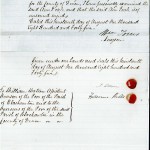Ann Foale was admitted to the DCLA on the 21st August 1845. The hospital had opened for male patients on the 22nd July 1845, its initial capacity being 440 beds. Female patients were admitted from August, and Ann, then aged 28, was amongst the first. She was unmarried and employed as a servant, admitted from the small village of Blackawton. It is not clear from her file whether she was admitted from her place of work, neither does the file reveal whether Ann originated as a Devonian or was amongst many young women moving to the area for employment. Ann was sent to the DCLA by the authority of John Allan and Fortescue Wells, Justices of the Peace. Surgeon William Toms who signed her medical certificate on 19 August 1845 declared her a person of ‘unsound mind’.
Once in hospital, Ann was diagnosed with mania which was, besides melancholia and dementia, one of the broadest and most prevalent descriptors of insanity in the 19th century. She was also described as a teetotaller who had not experienced privation, but suffered occasionally from ‘grief’ – again a very common umbrella term for various adverse circumstances – and as being ‘quite clean [in habits]’, but ‘violent to others’. Her admission documents refer to her as being in good physical health, except for influenza [1], and her case notes attribute a ‘moral’ cause to her mental illness which had been prevalent for four years before her admission to the DCLA and was defined by surgeon William Toms as a love affair. 19thcentury mental health aetiology distinguished between ‘physical’ and ‘moral’ causes, a categorisation that did not only attribute a certain degree of responsibility for their illness to the patient, but also contributed to the great stigma attached to mental disorders. This system was later replaced with the dichotomy of ‘predisposing’ and ‘exciting’ factors, already hinting at the fact that some people were considered to be more vulnerable to developing a mental disorder than others.
Ann’s case notes reveal little about her progress in hospital, but we know that she left the hospital ‘recovered’ on the 13th January 1846. During the early years of the DCLA, recovery rates of 30% to 40% seemingly attested to the success of the new, more humane, approach to the treatment of the insane. Unfortunately, closer inspection reveals grossly inflated rates, as the same patient could be discharged ‘recovered’ on several occasions. Ann was one of these readmissions. She managed to stay in the community for only about one month before requiring re-hospitalisation on the 19th February 1846. We also learn that the DCLA was not the first hospital Ann had been admitted to. Her case notes reveal that she had previously spent a year in the St Thomas’s Asylum in Exeter. On her second admission to the DCLA Ann stayed until her death from ‘phthisis’ on the 24th August 1872. In total, Ann spent more than 27 years, i.e. about half her life, in two Devon asylums.
[1] It is more likely that she was suffering from the ‘common cold’ to which people tended to refer as ‘flu’



